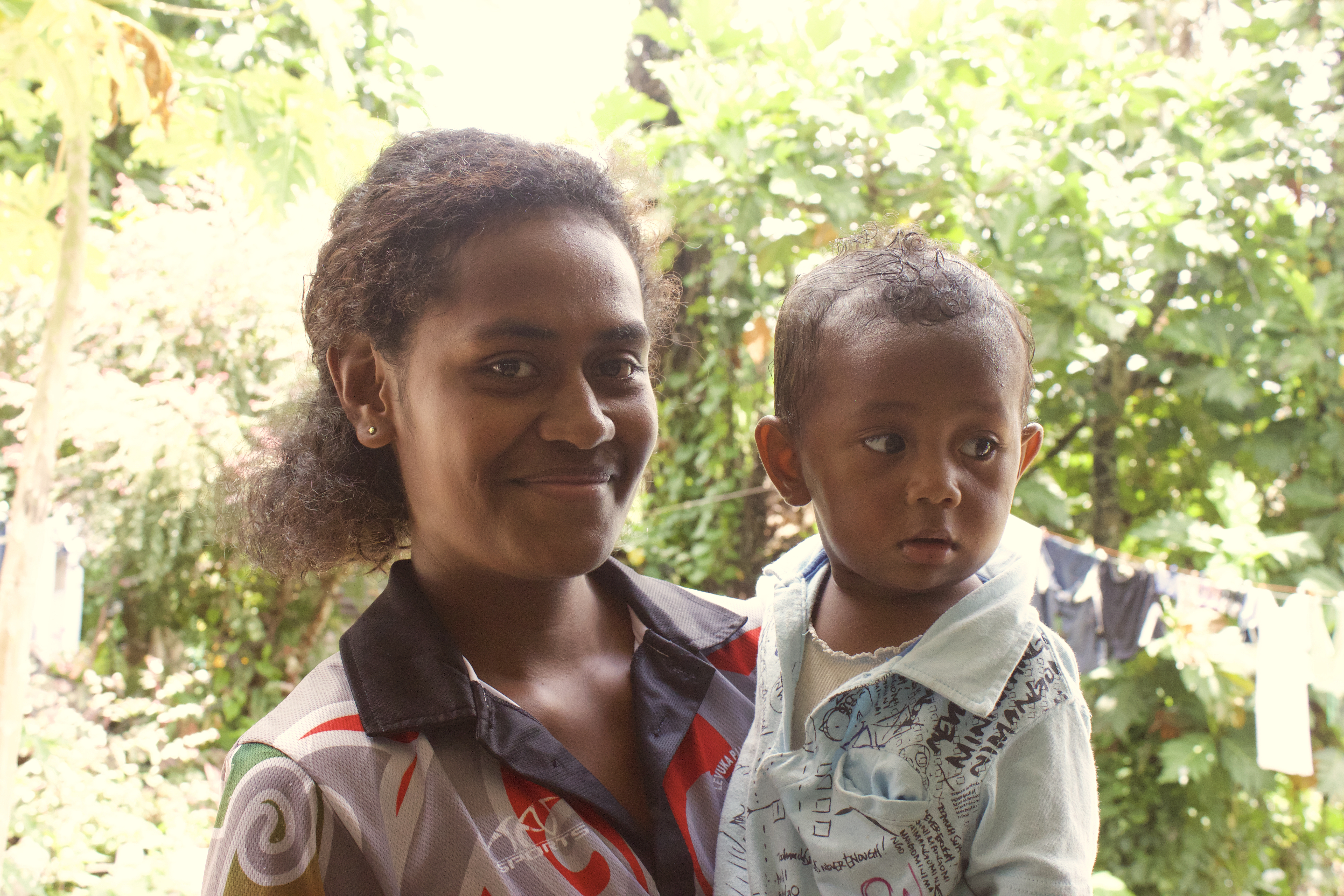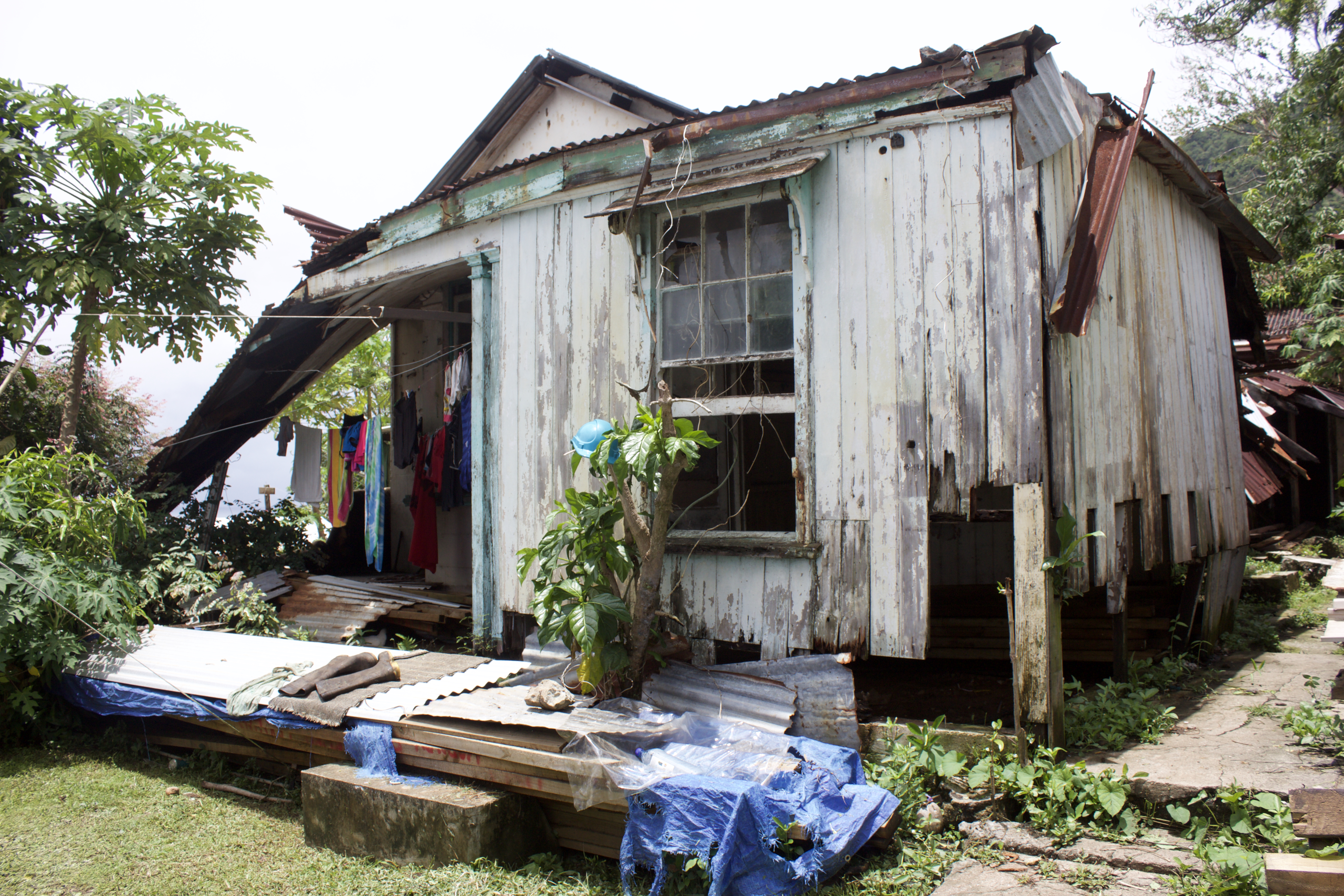

(Photo: Kate Wheeling/Pacific Standard)
Flora was alone in her home above the town of Levuka on Ovalau Isand on the afternoon of February 20th, 2016, when Cyclone Winston made landfall in Fiji and tore the wall off the room she was standing in. Her husband arrived minutes later to take her down to the school-turned-shelter in town. Most of her family was already there, including her young daughter, Tiloro.
Her sister-in-law Dana, however, was still on her way back from Bamba, another settlement just 20 minutes from Levuka if you’re going “bushway”—that is, through the forested hills of the island rather than taking the road that tracks along its coast. It was a Saturday when Winston first hit, and Dana—a tall 46-year-old with a guarded smile but eyes that betray her playful nature—had been visiting with family in Bamba.
As she walked home, the storm started to uproot trees all around her. By the time she got to her house, the roof was gone. She grabbed clothes and ran down the hill to the shelter.
Click here for more on Fijians’ everyday climate struggles.
They knew a cyclone was coming, but few Fijians beyond the country’s meteorologists had any idea how strong it would be. “What happened during the cyclone is that news reports kept saying, ‘It’s a Category 5 cyclone, it’s a Category 5 cyclone,'” says Faranisese Ratu, a youth activist in Fiji. “Nobody knows what the fuck that is.” Somewhere along the line from meteorologists to journalists to the public, the meaning of a Category 5 storm was lost, and not just to those on the outer islands; even in the bigger cities on Viti Levu, Fiji’s largest island, many residents were caught off-guard. “They didn’t say how destructive it would be,” says Ratu, “so by 2 p.m. that day, people were still going to the shops in downtown [Suva].”
By the time the cyclone passed, dozens of people were dead and tens of thousands were displaced, including Flora and Dana. In the immediate aftermath of the storm, the Fijian government handed out tents for families to live in temporarily, and cards good for the monetary value of the materials they needed to rebuild their homes. But the cards have come to be seen by many as a trick by the government to skirt its responsibility to help; building materials are scarce across Fiji, especially on the hardest-hit islands, where entire villages became construction zones. A handful of families on Ovalau are still waiting.
Today, Dana and Flora’s tents, alongside three others occupied by their extended family, stand in the yard in front of the house where Flora watched the wall come down. The “compound,” as they call it, is a 15-minute walk from town ending in a steep stone staircase, lined by bougainvillea, that cuts up through the verdant hillside. When it rains, as it did for 12 straight hours last night, a river of water streams down over the steps in a chain of tiny waterfalls.
A muddy footpath winds between the tents and through the ruins of the house, where many of the rooms have been reclaimed by vegetation. Chickens pick at the bugs that have surfaced to escape the waterlogged ground, and a pack of dogs romp around, sniffing at the tent openings. Most of them are still puppies—Dana’s dog had a litter just a few months ago—too young to have learned not to try to get inside. Everyone feels safer with the dogs around. “Whenever somebody comes around, the dogs bark,” says Dana’s 32-year-old sister, Inise, who shares several features with her older sister but has her own wide, easy smile. There’s no way to lock up the tents, and some of the women have had belongings stolen from inside.

(Photo: Kate Wheeling/Pacific Standard)
Before the storm, Inise was living in a relatively new house some 100 meters away; it was built just seven years before Winston. In a single afternoon last year, the cyclone flattened the whole house, save the bathroom, which they still use today.
Today, Inise lives in a tent with her 38-year-old partner Kelera and Kelera’s uncle. For about a year after the storm, Dana says, they all went without electricity. Now they have solar panels, which means they still only have light at night after days when there is enough sunshine to charge the solar battery. Of course, if the sun is out, it becomes stifling-hot inside the tents; on warm days like today, when heat emanates from the open flaps of the tent even before you enter, Flora seeks some shade and fresh air under the mango or coconut trees in the yard. Kelera’s uncle, who has been blind in one eye since the 1990s and in both since 2011, uses a cane to tap his way toward a cool slab of stone in the shade of the old house, where he lies down.
But the heat may be hardest on Wesley, a 14-month-old baby with thin tufts of hair that curl into a tiny faux-hawk. He has lived in the tent his entire life. His mother, a quiet 19-year-old named Alisi, says that, too often, Wesley is unable to sleep in the tent. “It’s too hot,” she says.
The families have made the compound as secure and homelike as possible, given structures as inherently impermanent as these tents. Inside, the floors are lined with mats and rugs, the beds are neatly made, potted plants and books sit on small tables. But time has worn the material thin in many places, and the mesh windows of each tent have been torn to streamers. Not long ago, a coconut punched a hole through the roof of Inise’s tent. It’s patched only with peeling tape. To prevent flooding, Dana raised her tent off the ground with wood pallets; the others dig trenches around their tents every time it rains. Titilia, 40, who shares her tent with her husband, one of her daughters, and her son, puts all their belongings in a plastic bag and stashes it in a hamper at the center of the tent to keep things dry.
But bad weather can level their homes all over again. Last December, the families were evacuated to the school for several days when a strong storm knocked over their tents. It took a week for everything to dry out in the sun. Once, a wind gust managed to move Flora’s tent several feet while she was still inside of it. They’re constantly adding more strings to try to hold the tents in place.
Dana has built a more permanent, elevated structure for the group from scrap pieces of wood and corrugated metal scavenged from her sister’s collapsed home. Rugs and mats cover the wood floor, while sheets of cloth and plastic hang over the metal walls. It’s a dry place to sleep when the tents flood, but mostly it’s a gathering place for family meetings, or for sharing bowls of grog, a relaxing drink made from kava root.
At night, when the air cools, the family often sits cross-legged around a bucket of water at the center of the structure, with a cloth bag of powdered kava root steeping inside. Beginning with Dana’s father, the patriarch of the family, they take turns drinking bowlfuls from halved coconut shells, clapping three times each time the shell is emptied, just as their ancestors did. Unlike their ancestors, many of the family members suck on lollipops or hard candy to chase the taste of the grog, which has the consistency and flavor of muddy water and a numbing effect on both mouths and anxieties. More friends and family trickle in, dropping bags of powdered kava or tangles of the thin dried root itself next to whichever young man is filling up the bowls. It’s better freshly ground, they say.
Between rounds, Wesley dances to pop music thumping from a portable speaker powered by the solar battery; when he tires of the attention, he cuddles up in the lap of his great uncle—the 74-year-old head of the family. Photos are snapped and quickly added to Facebook.
No one knows how many more days they’ll have like this, living in the tents. “The building materials are still coming in,” Inise says, adding that they’re still missing the main supplies they need to build the foundation. She’s anxious about spending another cyclone season without a solid shelter. “When we have even just a small bit of rain we get frightened,” she says, smiling but wringing her hands in her lap, “like it might blow away.”



